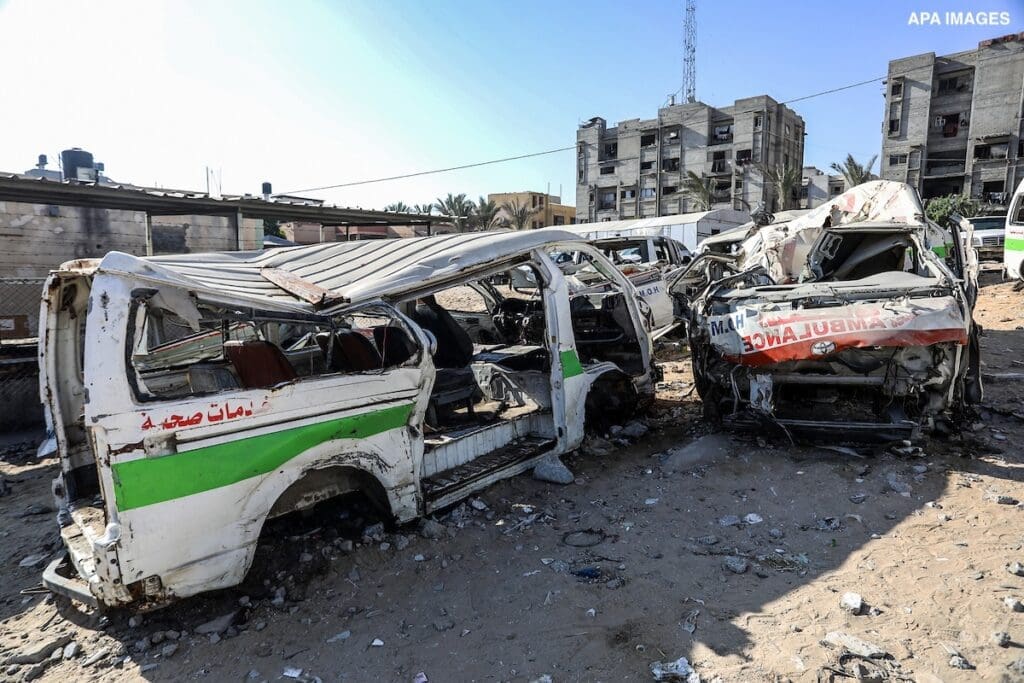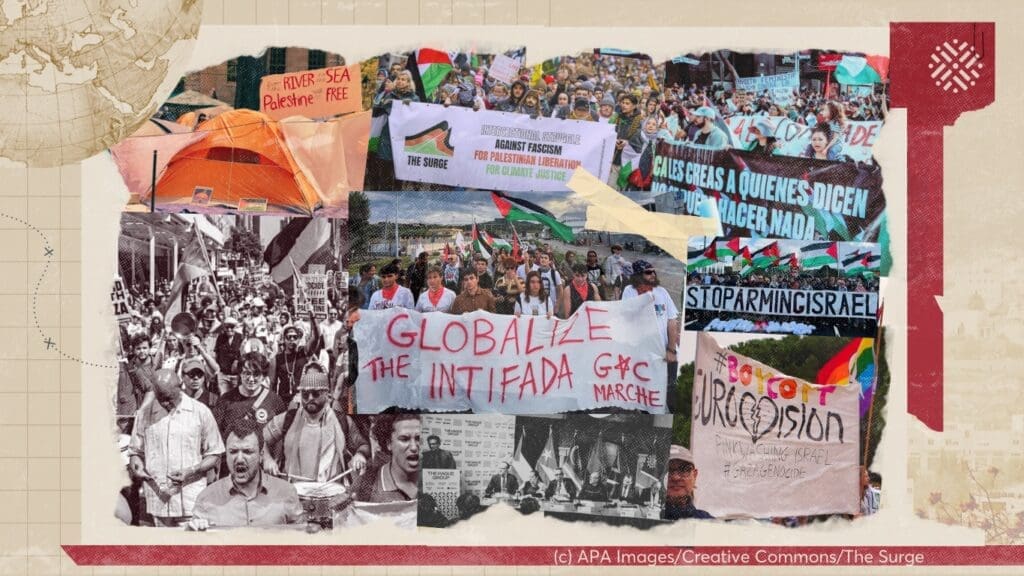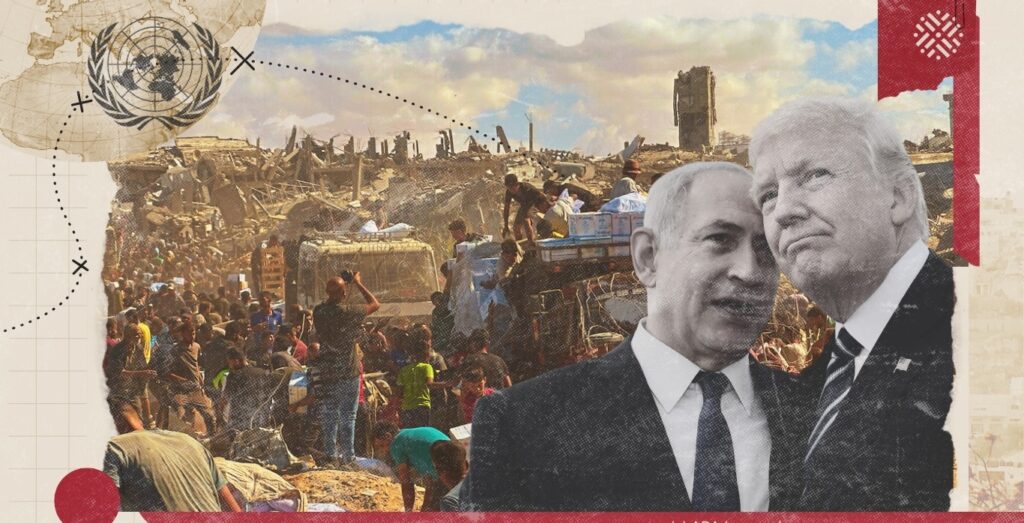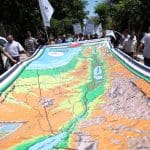
Overview
Since the signing of the 1993 Oslo Declaration of Principles, the donor community has invested more than $23 billion into “peace and development” in the Occupied Palestinian Territory (OPT), making it one of the highest per capita recipients of non-military aid in the world. However, aid has not brought peace, development, or security for the Palestinian people, let alone justice. Al-Shabaka Guest Author Jeremy Wildeman and Program Director Alaa Tartir examine the origins of the present aid-for-peace model as well as its effects on socio-economic conditions and pull together the many critiques of the Oslo economic model.
The authors argue that donors are reinforcing failed past patterns associated with the so-called peace dividends model while making only cosmetic changes to their engagement. Indeed, donors do not appear ready to change an approach dominated by policy “instrumentalists” who ignore and reject outcomes that do not match their pre-determined values instead of upholding international law on Palestinian rights and international development principles that strive to “do no harm.” They underscore the alarming possibility that the Oslo aid model may serve too many interests to be dismantled and conclude with an assessment of what will be needed for change.1
The Invention of the Oslo Economic Model
In 1993, soon after the first Oslo agreement was signed the World Bank laid out an economic plan for the Palestinians called An Investment in Peace. This plan was meant to guide major bilateral donors on how to disburse their aid in support of the peace process.2 It would do this by building institutions, fostering open and free markets, trade, investment, and financial liberalization, advancing good governance and regional economic integration. It also encouraged economic integration with Israel, at the same time that it was supposed to be preparing Palestinians for independence.3 In addition, a semi-autonomous Palestinian authority would be established to police Palestinians in the OPT in lieu of the Israeli military.
Closer economic integration with Israel was one of the main “successes” of the plan, beginning with the establishment in 1994 of the Paris Protocol as an annex to the Oslo Accords. The Paris Protocol created a customs union under which the Palestinian Authority (PA) would implement the Israeli trade and tariff policy and gave Israel the right to change policy and simply notify the PA of such changes. The Protocol regulated taxation, trade policy and established a Joint Economic Committee to manage the agreement. Under the Protocol’s customs envelope all foreign aid donated to the Palestinians had to pass through Israel, which was free to tax it.4 An Israeli negotiator involved in designing the protocol said it “basically legalised the forced marriage of the two economies since 1967.”
An Investment in Peace is a neoliberal policy plan which parallels other programs developed by international financial institutions for the developing world in the 1990s. Based on elements of the conventional wisdom of the Washington and Post-Washington Consensus, it ignored the fact that the Palestinian territories were under a longstanding military occupation, which gave neoliberalism in the OPT its own particularity and flavor. The philosophical rationale for the World Bank plan was to improve Palestinians’ standard of living and encourage them to participate in the peace process by cashing in on peace dividends.5 This rationale remains the same today: invest more money to make Palestinians feel better economically to make it easier for them to compromise politically.
As a result, Palestinians in the OPT have become one of the highest per capita recipients of non-military aid in the world. International aid disbursements to Palestinians totaled around $22.7 billion between 1993 and 2011, averaging $360 per capita annually. Aid inflows increased from an annual average of $656 million between 1993 and 2003 to over $1.9 billion since 2004. In fact, international aid increased by 17 times between 1993 and 2009 and the amounts disbursed from 2008 to 2012, during the term of former prime minister Salam Fayyad and further entrenchment of the neoliberal approach which came to be known as “Fayyadism,” exceeded the total amount of aid received between 1994 and 2005. At the peak of aid flows to the OPT in 2008-9 only Liberia and Timor-Leste had a higher level of aid as a percentage of the Gross Domestic Product (GDP.)
Is One Person’s Failure Another’s Success?
The World Bank’s Investment in Peace, which shaped how foreign aid has been disbursed to the Palestinians over the previous two decades, failed spectacularly in achieving its own goals: sustaining economic growth, fostering peace and establishing an independent Palestinian state. Nevertheless, the World Bank continues to exercise incredible influence over the aid process and to recommend the same policies, although some of these have become even more impractical over time, for example those set out in the Bank’s 2012 growth report, that we have previously critiqued.
Palestinians are far worse off today than they were in 1993 using any economic or political criterion. According to the income-based definition of poverty, 50% of Palestinians lived in poverty in 2009 and 2010, 38% in the West Bank and 70% in Gaza. The World Food Programme has found that 50% of Palestinian households suffer from food insecurity. Unemployment has been stuck at around 30% since 2009, with 47% unemployed in Gaza in 2010 and 20% in the West Bank. The unemployment rate for Palestinian youth under 30 is particularly alarming at 43%. The income and opportunities inequality gap continues to widen not only between the West Bank and Gaza, but also within the West Bank. Manufacturing and production capacities continue to erode.6 Meanwhile the agriculture sector that once drove the Palestinian economy remains sorely neglected: Since the PA’s establishment and the application of An Investment in Peace-guided aid programs, the amount allocated to the agriculture sector did not exceed 1% of the total PA annual budget between 2001 and 2005 and the agricultural sector’s contribution to GDP dropped from around 13.3% in 1994 to 5.9% in 2011. Furthermore, around 85% of the tiny budget allocated to agricultre went to Agriculture Ministry staff salaries.
Public debt has doubled, while private debt has ballooned because of easier access to credit. At the macro-economic level, the celebrated economic growth of 7.1% in 2008, 7.4% in 2009 and 9.3% in 2010 was an aid-driven jobless growth that excluded Jerusalem and simply reflected an economy recovering from a low base. Instead, Palestinians have become completely dependent on foreign aid to sustain their isolated enclaves in the West Bank and Gaza, a captive market based on aid money used to buy most of its needs from Israel.7 NGO-aid induced inflation, personal debt and rising cost-of-living have been linked to the stalled peace process – a process that has steadily seen life for Palestinians get worse and aspirations of self-determination recede.
At the political level, the PA, which administers a large proportion of the aid lacks both de jure and de facto sovereignty. Israeli settlement building and the confiscation of Palestinian land accelerated dramatically after Oslo, as did Israeli closure policies limiting Palestinian entry to work in Israel or move freely within the OPT and with the rest of the world, a primary factor in the steep decline of the Palestinian economy.8 Daily Israeli armed raids have resulted in the death, disability, and the imprisonment of tens of thousands of Palestinians. The deductions from the wages and salaries of the Palestinian workers in Israel between 1970 and 1993 – which totaled 16.5 billion Israeli shekels – are still benefiting the Israeli economy. The PA has been powerless to fight for these workers’ rights or the lost revenue to its treasury9. In the final analysis, aid is being used to sustain a failed peace process as well as the Israeli occupation itself.
It comes as no surprise that there is broad agreement in the literature that aid has failed the Palestinian people. However, there is disagreement as to why aid has failed and we have identified four schools of thought.10 One group can be termed “instrumentalist” and argues that the fundamentals of An Investment in Peace are sound and the model should be maintained but simply needs to be better applied. This group tends to sanitize the Israeli occupation and the settler colonial nature of the Israeli state. It ignores Israel’s remarkably consistent policies towards Palestinian land and people since a time that predates the formation of the state of Israel. It also lays a disproportionate amount of blame on the PA for the failure of aid to achieve results.
This group includes researchers at the World Bank, the International Monetary Fund, and many bilateral government donor agencies. The instrumentalist approach helps to explain why the model adopted in 1993 with An Investment in Peace has not changed after two decades of conflict and economic collapse. A second group, the “critical instrumentalists,” do focus on the occupation as the main obstacle to peace and development. However, they share the instrumentalist faith in the ability of policy to bring about positive change.
The third group consists of critics of the Oslo aid model. Many in this group assert that the aid model is itself a part of the occupation, because it is designed in a way that subverts Palestinian development while reinforcing and subsidizing the Israeli occupation, along with longstanding Israeli policies dating back to the 1948 Nakba and beyond.11 For critics, development is not policy to be implemented, but domination to be resisted, because in the case of Israel-Palestine the hidden intent behind development aid is to reinforce the occupation.
There is a fourth group not often considered when analyzing the impact of aid: The neo-colonialists, who consider aspects of foreign aid to have been a success. Particularly in the West Bank, Palestinian resistance to the Israeli occupation has largely been mollified and Israel’s policy aims have largely been achieved. This perspective is highly influential, especially in the United States, where it is very effective in aligning itself with Israeli government interests while largely defining American aid policy toward the Palestinians. For example, organizations such as the Washington Institute for Near East Policy have since at least the 1980s been advocating an approach to aid that provides economic incentives to Palestinians in return for their giving up rights.
The impact of the neo-colonialists is perceptible. A June 15, 2012 Congressional Research Service report spelled this out when it noted that aid for the Palestinians has been intended, over the years, to support at least three major U.S. policy priorities: Combating terrorism against Israel; encouraging Palestinian peaceful coexistence with Israel while preparing Palestinians for self-governance; and meeting humanitarian needs to prevent further destabilization. The first point has been expanded to include opposition to a Palestinian bid for recognition as a state at the United Nations and to any initiatives aimed at increasing international recognition outside of the “peace process.”
When foreign aid to Palestinians is analyzed from a neo-colonial perspective, it may not be failing at all. With an increasingly subdued Palestinian population in the West Bank governed by a pliant PA, Gaza locked up and surrounded by an impenetrable blockade, and Palestinians in Jerusalem being squeezed out, aid may actually be a great success. It encourages Palestinians to give up any kind of resistance to the Israeli occupation and keeps them fed and subdued, and Israel can apply a financial boycott when they resist these processes. Meanwhile, Israel swallows up the OPT without having to foot the costs of those living under occupation.12
What Future for the Oslo Model?
As noted above, even though the Oslo model is a failure as far as Palestinian national aspirations and universal rights are concerned, it serves Israel’s interests. Israel’s influence in the U.S., when combined with the instrumentalist view that the problem with aid lies not in the model but in its application, means that Oslo may be around for many years. Our conclusion is reinforced by interviews with informed observers of donor policies in the OPT. For example, a Palestinian West Bank-based critic of Oslo noted that even though some new donor programs had been introduced “these new programs are directly linked with the peace and normalization, in particular those of the Europeans.” Another observer affirmed there is a push for joint projects, which “are aimed at breaking the resistance of Palestinians …[and] for the subjugation of the Palestinians to the Israelis.”13
As for the donors, one major donor noted that there was no “specific change” in OPT programs – other than “re-emphasizing the regional importance of resolving the Israeli-Palestinian conflict, and the relevance of [our] approach to Palestinian state-building.” Another major donor even went further to say that the Palestinian model was something that could be exported to the Arab world, given that their programs were “well advanced” in the OPT.14
Yet even though the donor approach has not fundamentally changed, Palestinian attitudes toward aid have soured and increasingly echo the critical perspective of aid. There is growing anger toward international aid agencies that has moved beyond elite circles to the Palestinian street, and there have been many protests. These have included protests against the Paris Protocol, including by PA-related figures, although they are mostly confined to newspapers and media outlets. There have also been protests against USAID, which was the focus of anger during President Barack Obama’s recent visit, as well as against the European Union Coordinating Office for Palestinian Police Support and the Japan International Cooperation Agency (JICA).
Unfortunately, for those critics who aspire for a change in – if not a complete overhaul of –the aid model, the protests remain on the side-lines of the debate with little influence over policy. A perceptive donor pointed out that Palestinian protests were limited to issues that did not really challenge those in control and were not aimed at a strategic readjustment internally or toward Israel. For example, they said that the large protests focusing on economic conditions and on hunger-striking prisoners in fact “illustrate the timidity and limited horizons of Palestinian politics.”15 Once protests exceed the boundaries set by the bifurcated leadership in the West Bank and Gaza they get reined back in.
In short, with little in the way of serious protest, there is nothing to compel donors, the PA or Israel to change their approach. Indeed, the most notable shift may be the role of Arab donors that have stepped in to support the existing model and possibly make it worse by increasing its structural deficiencies, such as recent Qatari investment into Gaza. U.S. Secretary of State John Kerry’s latest economic peace initiative appears to be in line with the long-standing American policy of funding a “peace dividend” to help keep the Palestinians quiet and provide additional incentives for Palestinian negotiators to offer further compromises. The $4 billion plan intends to increase GDP by 50% over the next three years, which will further pacify the conflict. Alongside this Kerry plan is the “breaking the impasse” initiative that has brought together some 300 Palestinian and Israeli businessmen to kick-start a new wave of economic normalization.
In Search of a New Aid Paradigm
Some of those we interviewed made suggestions for change that challenge the Israeli occupation and the violation of Palestinian rights. These include strengthening the PA so that it can lead the development process, rather than just letting donors set the agenda; ensuring that aid does not create dependency or subsidize the occupation; redirecting aid from relief to development; increasing the amount of aid spent locally and decreasing the amount reverting to donors; and ensuring that aid does not reduce Israel’s obligations as an occupying power.
However, many critics of aid want to go further and to challenge the overall framework and comprehensively overhaul the existing paradigm. According to these voices, the keys to effective aid include:
- Aid must support Palestinian self-determination and help the Palestinians resist the colonial project. It must not subsidize Israel’s occupation.
- A unified Palestinian political, economic and developmental program is essential.
- Aid should enable Palestinians to challenge Israel’s control over resources and borders, which could for example include tapping gas reserves located off the Gaza Strip that Israel has so far blocked.
- There is a need to end reliance on the U.S. by connecting with other regional and international powers, and with global civil society.
- Political sovereignty is a must for effective aid; better aid allocation or more resources within a dependency relationship will change nothing.
- Donors need to align themselves with the demands of Palestinian national movements such as the Boycott, Divestment and Sanctions movement (BDS).16
According to these critical voices, then, the development paradigm must urgently be shifted from one that considers development as a technocratic, apolitical and “neutral” approach into a model that recognizes structures of power, relations of colonial dominance and rearticulates processes of development as linked to the struggle for rights, resistance and emancipation. In essence, as one aid critic put it: “What we need is to get rid of Oslo and everything attached to it.”
The time to work for change is now, especially since many donor projects will need to be renewed and refunded in 2013-14. Palestinians need to be organized to set the agenda. Otherwise, the aid industry’s approach will remain the same, with a rule of thumb that: “The US decides, the World Bank leads, the EU pays, the UN feeds.”17
- Wildeman and Tartir presented the results of an in-depth study based on extensive interviews with both donors and aid critics at a workshop entitled “The Politics of Foreign Aid in the Arab Middle East: Have the Arab Uprisings Changed the Practice?” organized by New York University and the London School of Economics in Florence, Italy on June 28, 2013. The study has been submitted for academic publication under the title “Unwilling to Change, Determined to Fail: Donor Aid in Occupied Palestine in the aftermath of the Arab Uprisings”.
- World Bank (1993) Developing the Occupied Territories: An Investment in Peace, Washington. D.C.
- Taghdisi-Rad, S. (2011) The Political Economy of Aid in Palestine: Relief from Conflict or Development Delayed, Routledge and LMEI, London, U.K.
- Toaldo. M. (2013) Beyond the Paris Protocol: Reforming Israeli-Palestinian Economic Relations; Pivoting to Palestinian Economic Sovereignty, The Middle East Peace Process Project, European Council on Foreign Relations, U.K.
- Le More, A. (2008) International Assistance to the Palestinians after Oslo: Political Guilt, Wasted Money, Routledge, U.K.
- Sara Roy foresaw this process in her The Gaza Strip: The Political Economy of De-Development (1995), Institute for Palestine Studies, Washington. D.C.
- Hever, S. (2010) The Political Economy of Israel’s Occupation: Repression Beyond Exploitation, Pluto Press.
- Farsakh, L. (2002) “Palestinian Labor Flows to the Israeli Economy: A Finished Story?”, Journal of Palestine Studies, Vol. 32, No. 1 (Autumn 2002), pp. 13-27.
- According to the UNCTAD latest report, the PA is losing at least $300 million a year in customs, purchase and value-added taxes which are not transferred to the Palestinian treasury by Israel.
- For a fuller discussion of all four groups, see our forthcoming study “Unwilling to Change, Determined Failure: Donor Aid in Occupied Palestine in the aftermath of the Arab Uprisings”.
- Khalidi, R. and Samour, S. (2011) ‘Neoliberalism as Liberation: The Statehood Program and the Remaking of the Palestinian National Movement’, Journal of Palestine Studies, Vol. XL, No. 2, pp. 6–25; Khalidi, R. and Taghdisi-Rad, S., (2009) The Economic Dimensions of Prolonged Occupation: Continuity and Change in Israeli Policy towards the Palestinian Economy, UNCTAD, Geneva; Nakhleh, K. (2011) Globalized Palestine: The National Sell-Out of a Homeland, The RedSea Press, Inc. See also critiques by Abdelnour and Tartir, Abdelnour and Bahour of Al-Shabaka.
- Prior to the Oslo process, in the 1980s Israel relied on Jordan and foreign assistance flowing through Jordan to help offset those costs: “From the Israeli perspective, Jordan’s economic support ironically made it easier for Israel to exert control over the territories.” Starr, J. (1989) Development Diplomacy: U.S. Economic Assistance to the West Bank and Gaza.
- Authors interviews.
- Authors interviews.
- Authors interviews.
- Authors interviews.
- Le More, A. (2005) Killing with Kindness: Funding the Demise of a Palestinian State’, International Affairs, 81(5), pp. 981–999, p. 995.














